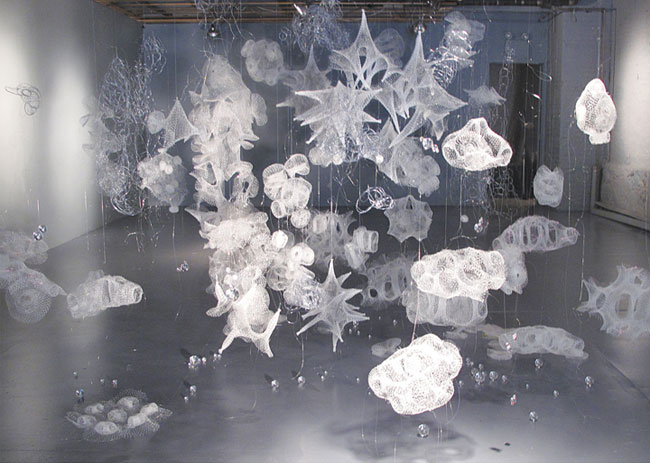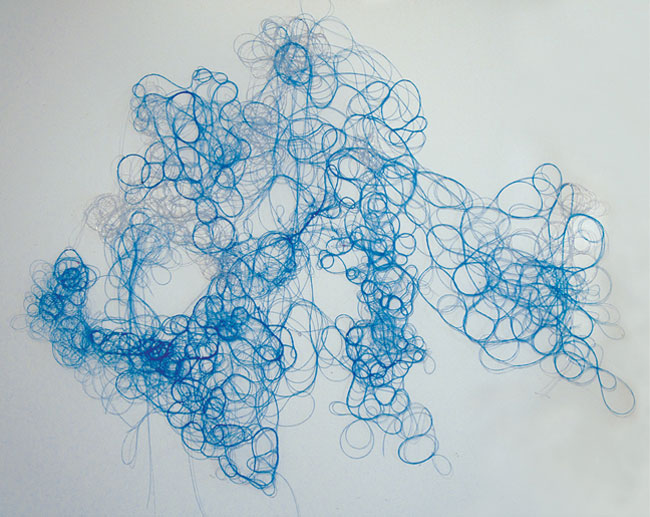by Rachel Ton That
Last Sunday I was invited last minute to attend a gallery opening in Brooklyn. The gallery space, called FiveMyles, is unassumingly tucked away on a quiet street close to the Brooklyn Museum with only a plain façade and discreet sign to indicate the entrance. Inside, however, the discovery felt like a revelation: the exhibit featured several sculptural installations by Caroline Cox and a series of paintings by C. Michael Norton. Cox’s delicate sculptures, constructed from nylon fishing line and plastic mesh, were fascinating, ethereal and all the more exquisite to have come from such humble materials. When a mutual acquaintance introduced us I took the opportunity to ask her for an interview.

Spin (food packaging mesh, acrylic balls, monofilament)
First, could you tell me about some of your inspirations?
When I was around six years old, my Grandmother started teaching me how to sew. I remember being amazed at how flat, pliable fabric could be transformed into a hollow form, and how the fabric was made from thin woven threads. In private I made small, strange weavings by poking straight pins into the upholstered furniture and winding thread around and through them curving in every direction, not straight or in a grid. I remember being confused as to why I was doing this and always took them apart immediately after they were done. My fascination with folding, weaving, stitching and knotting was reinforced during a field trip in elementary school to Sutter’s Fort where I first encountered the art and everyday objects made by Native Americans. Looking back they were probably the Nisenan Maidu, who had inhabited the area where I was living, outside of Sacramento, long before Europeans came. I observed that all of their basketry, clothes and decorative items were in some way woven, tied or sewn.
While I was in elementary school I spent a large amount of unstructured time wandering in nature, speculating that indentations in rocks were where Native Americans had ground their acorns, and just looking at things, observing how wild plants grew together in a tangle. I could immerse myself in slowed down time, the subtle nuances of changing light, and the soundtrack of bugs. Much later I learned about ideas of evolution; I was amazed and inspired by the way these concepts connected all things into a constantly churning, changing and responsive mix. The organic forms I once observed were blown apart and put back together in a way that seemingly no one could fully understand.
Around this time I also became aware of improvisation through the music of Thelonious Monk and other artists. Later I moved to NYC and became involved in the downtown experimental music scene that John Zorn was influential in, and I played in an improv noise band, The Chairs. The unstructured immediacy of this music transformed my visual art and how I thought about content.

Looping, 5" x 7", monofilament
Do you intentionally reference marine life, or is this coincidental in your current exhibition?
I make my work without sketches or pre-planning – it typically goes through numerous permutations. I set the piece in motion focusing on the materials that I use, ignoring content. I want the piece to come into being through the process. My interests are eclectic and I incorporate diverse materials, objects and ideas into my installations. While making this piece I was particularly interested in a wide range of natural structures: from warping of the space/time fabric to diatoms to microscopic structures of mold. I trusted that these interests would surface during the process of making the piece and I didn’t consciously introduce them. Viewers at the opening of Spin – the title of this current series of mine on exhibit at FiveMyles – related a wide range of associations or references that ranged from marine life to black holes, and molecules to lace.
While the mesh components can be a source of multiple associations and references, during the construction of the installation I approached them as experiments in the transformation of the material and its tubular structure. The mesh comes as one very long condensed tube wrapped on a large spool. The individual components were unique investigations into possible variations and mutations, much as I imagined would happen during the natural process of evolution.
What do you feel like this current work represents for you? Do you think this is a new incarnation of an old idea, a turning point, or an entirely new theme?
One unique aspect of Spin compared to my other work is that the mesh components are more self-contained, even though they are unified by their material and how they’re put together. They’re constructed from sections pinned together with roller picks and then hand-sewn with monofilament. Because they are porous and hollow the surface becomes the structure in a more pronounced way than in previous pieces.
I’ve always used photography as a way to get a different take on my work, I’m interested in seeing the work flat with its shadows. The Spin images (not included in the installation) that I’ve shot of the mesh components moving at slow speeds look more like misshapen tornados. The internal structures are as accessible as the surface is to the camera and the way these inner chambers read is unexpected.
My work has always been static before with the exception of ‘Scuse Me While I Kiss The Sky which unintentionally was set in motion by the gallery’s enormous heater. This accidental kinetic installation has stuck in my mind and when I saw how easily the light components of Spin moved and what it brought to the piece, I decided to incorporate movement into the work.
Finally, what was your experience at FiveMyles? How did you work with the curator to put the exhibit together?
FiveMyles is a very unique gallery because of the way Hanne Tierney, who is also a performance artist, runs it. Hanne integrates the gallery into the neighborhood and has an open door policy. The people in the neighborhood work at the gallery and she is an advocate for her neighbors in many ways – you can’t spend too much time there without getting caught up in it. I met Hanne several years ago through Marianne Griffiths, who founded and ran Sculpture Center when it was in Manhattan. Many of my contemporaries have shown at FiveMyles; it has been in existence for 12 years. Last year Hanne contacted me to set up a studio visit and later invited me to do an exhibition. When it came close to the show we met at the gallery and very casually bounced ideas around and it was quite easy to come up with a plan.
Spin (2011) was made for FiveMyles’ unique exhibition space, with its grey walls and floor. I knew the white components would not disappear as they were hung off the ground and got closer to the ceiling as they would in a space with white walls; so I took this opportunity to develop a piece where the exhibition space played down the figure ground distinction and viewers could feel more submerged in the work.
My work is physically transparent, so I’m always concerned about the context that I put it in. Fortunately, for the most part, viewers are pretty good at focusing in on what they want to see.
Caroline Cox is an artist living and working in New York City. More of her work can be found at carolinecox.com

You must log in to post a comment.